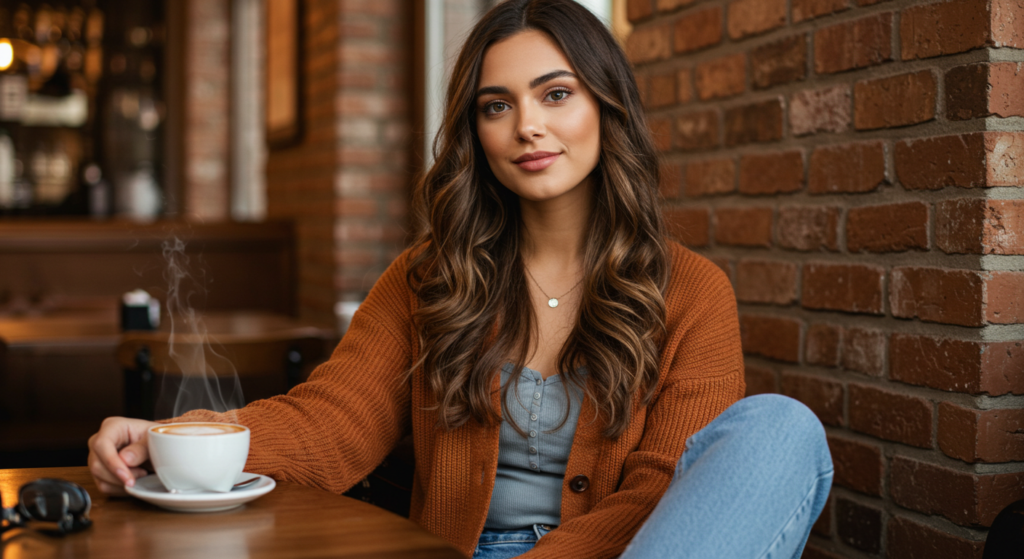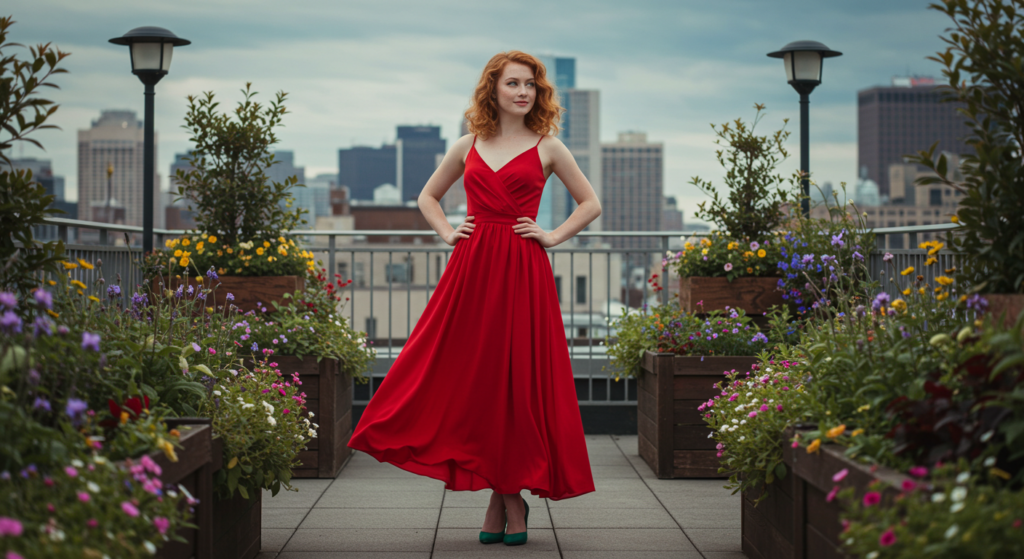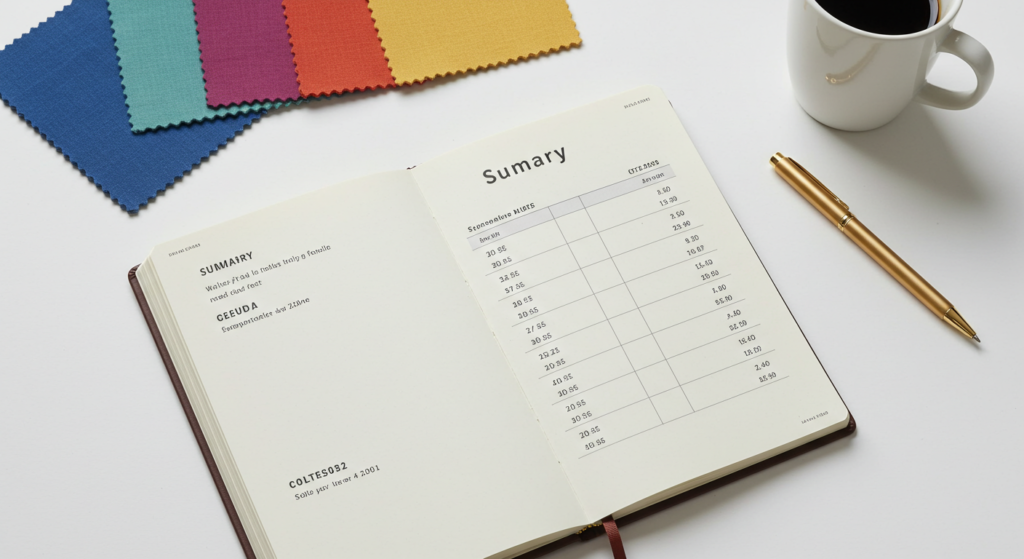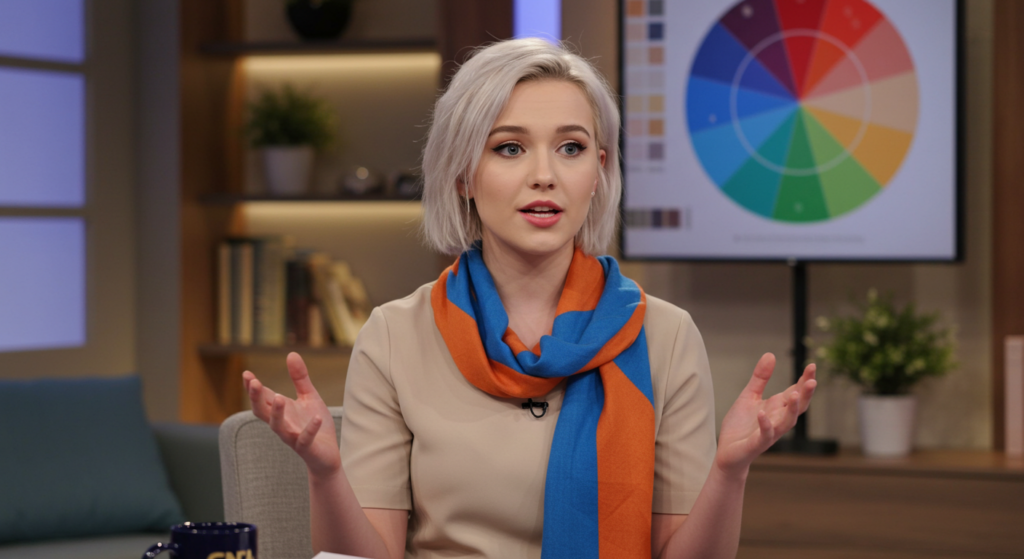Key Takeaways
- Complementary pairs (like red-green, blue-orange, and yellow-purple) create standout looks that grab attention.
- Balancing tones is key to achieving harmony between vibrant and neutral pieces.
- Layering and accessorizing can bring new depth to complementary color outfits, making them practical, creative, and easy to wear.

Complementary colors in fashion add excitement, energy, and a fresh twist to everyday outfits. They’re the pairs sitting opposite each other on the color wheel, and when combined, they offer a pleasing contrast that elevates any look.
Whether you’re a fashion newbie or a seasoned style enthusiast, understanding how to work with opposite hues can expand your wardrobe in surprising ways.
This article takes a practical deep dive into the art of complementary color styling. You’ll get insider tips on color pairing, layering, fabric choices, accessorizing, and more. We’ll walk through fourteen comprehensive sections, each with three helpful subsections, plus additional resources like a summary table and answers to frequently asked questions. By the end, you’ll feel confident rocking these striking combos, whether you’re dressing for work, a party, or a relaxed weekend. Let’s begin!
Understanding Complementary Colors

Complementary colors are all about contrast. They lie across from each other on the color wheel, creating a vivid pop when placed side by side. Mastering this concept gives you the freedom to experiment with your wardrobe in ways you might never have tried before.
The Basics of Contrast
You don’t need an advanced art degree to work with complementary colors. Look at a simple color wheel and locate the pairs:
- Red and Green
- Blue and Orange
- Yellow and Purple
Each duo delivers its own unique vibe. Red and green can look festive or bold depending on how you style them. Blue and orange is a favorite for color blocking and street-style outfits. Yellow and purple can be regal or playful, depending on shades and fabrics.
Chromatic Opposites in Wardrobe
Think of complementary colors as fashion’s dynamic duo. They bring out the best in each other. When you use them in your closet, you’ll find that even a single complementary pop—like a green scarf with a red coat—makes your entire outfit stand out.
A great starting approach is to mix one main color with an accent from its opposite side. If you’re cautious, begin small with accessories like belts, hats, or shoes in that contrasting hue.
Why Pairing Opposites Works
It’s not just about being loud or flashy. It’s about contrast that’s visually appealing. The human eye finds opposing colors interesting, which is why they often become runway favorites or editorial staples. Complementary color combinations in fashion also allow you to reinvent classic pieces. A simple blue blazer can transform when paired with an orange camisole or accessorized with an orange bag.
The Role of the Color Wheel

A color wheel is your compass to navigate complementary color choices. Even if you’re not an artist, you can rely on this simple circle to guide your next outfit. When you spot color pairs sitting directly opposite each other, you’ve identified a bold partnership that can truly elevate your style.
The Simple Wheel
Color wheels come in various forms, but at their core, they help classify hues into primary, secondary, and tertiary categories. For fashion, keep it simple:
- Primary: Red, Yellow, Blue
- Secondary: Green, Purple, Orange
- Tertiary: Combinations like Teal, Magenta, Mustard, etc.
To find complements, draw an imaginary line across the center of the wheel. If a color sits on one side, its complement is on the direct opposite.
Classic Combos
Red-Green, Blue-Orange, and Yellow-Purple are the most recognized complementary pairs. But there are endless variations. In modern fashion, you see combos like teal with tangerine or burgundy with hunter green, which are toned-down versions of the classic pairs.
These variations are perfect if you’re seeking a subtler approach. They create depth and sophistication, especially when combined with neutrals like black, white, or gray.
Neutral Incorporations
Neutrals play a supporting role in your complementary color outfits. Whether you’re mixing bright tones or subdued shades, adding white, black, beige, or gray can break up strong contrasts and make your ensemble more approachable.
A simple tip is to place neutral layers between your complementary pieces. For instance, a white tee under a bright blue blazer, paired with orange pants, lets each element stand out without clashing.
Red and Green: Beyond the Holiday Look

Red and green often get labeled as a holiday duo. But there are plenty of ways to wear this combination all year without looking like a festive decoration. It’s a vibrant pair that can be both edgy and chic if done right.
Subtle Shades
Bright red and vibrant green can feel overwhelming if worn in large blocks. Instead, consider subdued tones like burgundy and forest green. They still offer the same complementary contrast but lend a more relaxed vibe.
Try a burgundy sweater over a flowy forest green skirt. Top it off with a neutral belt. This approach is softer, more understated, and ideal for daily wear.
Creative Separates
Another way to rock red and green is by using separates. That means you can have a green dress with red shoes, or red trousers with a green blouse. If you’re worried about overdoing it, accessorize lightly. A red belt or a green clutch can be enough to tie the outfit together.
Transitional Touches
Red and green are excellent transitional colors for in-between seasons. A lighter shade of green pant paired with a red jacket is a perfect spring or early autumn combination. In cooler weather, you can experiment with layering: add a chunky sweater or a neutral coat that picks up tones of either red or green.
Blue and Orange: A Street-Style Favorite

Blue and orange are beloved by the street-style scene. You’ll see bright, electric blues paired with fun, fiery oranges on runways and in everyday urban looks. This duo can be sporty, elegant, or edgy, depending on how you style it.
Color Blocking Basics
One of the most popular ways to combine blue and orange is through color blocking. This technique involves wearing large, solid blocks of color next to each other. For example, you might style a cobalt blue blazer with a bright orange skirt. Keep the rest of your outfit neutral, so the focus stays on your vibrant pieces.
Denim and Earthy Tones
Blue and orange can be as simple as denim and rust orange. Jeans are a staple in almost everyone’s closet, and pairing them with a rust orange sweater or jacket makes for an effortlessly stylish look. Add boots or sneakers for a casual vibe, or swap in heels if you want something dressier.
Accessory Highlights
Accessories make it easy to add an orange pop to a blue outfit or vice versa. A blue bag paired with an orange dress or orange sandals with a blue romper instantly steps up your fashion game. If you’re not sure how to balance these colors, add a neutral piece—a white T-shirt or black pants—to keep it cohesive.
Yellow and Purple: Royal with a Twist

Yellow and purple are sometimes associated with regal occasions, especially deeper shades like gold and plum. But don’t restrict them to fancy events. This complementary pair can be playful, minimalistic, or luxurious, depending on your approach.
Everyday Chic
For a casual take, try pairing a soft lavender blouse with a pale yellow skirt or shorts. This light-on-light approach creates a gentle contrast that’s easy on the eyes. If you’re feeling adventurous, add a pop of deeper purple or a bright yellow accessory to draw attention.
Vibrant Statements
Go bolder with full-bodied yellow (like lemon or mustard) and pair it with a strong purple (like eggplant or violet). This look can be fantastic for events or parties, where you want an outfit that stands out. Consider layering a purple blazer over a yellow jumpsuit or combining a yellow top with purple pants.
Complement with Patterns
If you’re worried about wearing solid purple and yellow together, consider patterns. A floral print that includes soft shades of purple and yellow can tie the colors together in a more organic way. Or try stripes or checks that use these complementary shades in smaller proportions.
Accessorizing with Complementary Colors

Sometimes you don’t want an entirely bold outfit. Accessories are a great way to dip your toes into complementary territory. From jewelry to bags and shoes, these finishing touches can make any look pop without overwhelming your style.
Statement Jewelry
Large earrings, chunky necklaces, or bold rings in a complementary color can instantly spice up a neutral outfit. For instance, if you’re wearing a simple black dress, try an orange statement necklace with matching orange-and-blue earrings to bring in that blue-orange pop.
Bags, Scarves, and Belts
These smaller pieces can be your secret weapon. A teal scarf paired with a coral outfit or a mustard belt worn over a purple dress can transform your look from safe to striking. If you’re uncertain, start with a single complementary item that acts as a highlight against more neutral pieces.
Footwear Finishing Touches
Shoes are the anchor of your outfit. Try pairing green pumps with a red blouse and black trousers, or rock orange sneakers with a blue windbreaker and denim. This approach works especially well if the rest of your look is toned down, allowing your footwear to make the statement.
Layering Techniques for Complementary Success

Layering is a must for cooler climates or transitional seasons. It’s also an excellent strategy for wearing complementary colors without feeling like you’re drowning in them. The right layers help break up strong hues, providing a balanced and fashionable ensemble.
Mixing Textures
Combine different fabric textures to add depth. A satin orange blouse under a chunky knit blue cardigan, for example, feels plush and visually intriguing. Mixing velvet with denim, or lace with leather, also lets you play with the intensity of your chosen color pair.
Strategic Peekaboo
Show only glimpses of your complementary color. Let a bright cuff peek out from under a neutral jacket, or use layering so a colorful collar is visible against a complementary scarf. Little accents can be just as impactful as large color blocks.
Dress and Outerwear Combos
If you have a solid orange dress, pair it with a blue trench coat. Or, if you’re wearing a green top, throw on a deep red blazer. These pairings keep you cozy in colder weather and bring a polished look. You can also incorporate a neutral coat or sweater if you want to tone down the contrast.
Textiles and Patterns that Work Well

Not all fabrics or patterns will highlight complementary colors in the same way. Some might mute the contrast, while others accentuate it. Explore various textiles and prints to find the right combination that speaks to you.
Prints with Built-In Complements
Look for prints that already feature complementary colors. Paisleys, florals, stripes, or abstract patterns can have a balanced mix of red-green, blue-orange, or yellow-purple. This makes styling straightforward, as you can simply pull a color from the pattern for your accessories or additional layers.
Playing with Stripes
Stripes are a timeless pattern. You could pair a blue-and-white striped top with an orange skirt. The complementary aspect shines because the stripe’s neutral base (white) won’t clash. Alternatively, a two-tone stripe in one color can be matched with a complementary belt or bag.
Fabric Finishes
Some fabrics reflect light differently. Shiny finishes like satin or silk can amplify bright colors, while matte finishes like linen or cotton tend to soften them. Use this knowledge to control how intense your complementary pairing appears. If you want a subtle effect, opt for matte finishes in subdued shades.
Mixing Multiple Complementary Pairs

Who says you can only choose one complementary pair at a time? You can mix different sets of complementary colors if you do it strategically. This approach is perfect for bold dressers who love making a statement.
Balancing Act
When mixing multiple pairs, choose one pair to be the primary focus, with the others acting as accents. For example, you might wear a purple jumpsuit with a mustard belt (yellow-purple pair) and add a small orange clutch with blue detailing to hint at another complementary set (blue-orange). Keep the rest of your look neutral to avoid visual chaos.
Mind Your Proportions
If you’re combining red-green and blue-orange in one outfit, be mindful of how much space each pair takes up. You might wear red pants and a green top (dominant pair) with an orange scarf and blue shoes (secondary pair). Striking this balance prevents the outfit from feeling too busy.
Layered Outfit Planning
Start with your main complementary pair as the base layer (like a purple sweater over a yellow T-shirt). Then add a jacket or accessory from another pair. Always remember that less is more when you’re dealing with strong contrasts. Keep layering minimal yet intentional.
Complementary Color Fashion Across Seasons

Complementary colors can be worn year-round, but certain shades might suit specific seasons better. Warm, rich tones fit cooler months, while bright, fresh hues are perfect for spring and summer.
Spring and Summer Shades
In warmer seasons, opt for lighter tints like pastel orange with baby blue, or a lemony yellow with lavender. These combos look breezy and refreshing. Accessories like straw hats, lightweight scarves, and open-toed sandals in a complementary color can effortlessly tie a look together.
Fall and Winter Hues
Cooler months call for deeper, richer tones like burgundy with forest green or mustard with plum. Layering becomes more important, so incorporate cozy items like knits, jackets, and boots. Use neutral base layers to make the complementary pair the focal point.
Transitional Wardrobe Tips
As weather shifts, transition your complementary palette by swapping out fabrics rather than colors. For instance, switch from a light cotton orange blouse in summer to a thicker knit or a corduroy jacket in the same hue for fall. Maintain the same complementary scheme but adapt it to the climate.
Workwear and Professional Outfits

Complementary colors can fit seamlessly into a professional wardrobe, so long as you choose refined silhouettes and more muted versions of these color pairs. Impress your colleagues with a subtle yet polished approach to this style.
Subtle Blends
For office settings, avoid loud color blocking. Instead, pair a deeper navy suit with a burnt orange blouse or tie. The effect is still interesting but feels more business-appropriate. You can also add a green accent (like a scarf or belt) to a red blouse but keep the rest of the outfit neutral, such as a charcoal skirt or blazer.
Accessories as Accents
If a bright complementary outfit feels too bold for your workplace, opt for small accents. A bag, statement necklace, or shoes can introduce the second color without dominating. This approach keeps it understated but stylish.
Polished Finishes
Select structured pieces in quality fabrics. For example, a tailored pencil skirt in navy blue, paired with a well-fitted orange blouse, looks chic. Keep your accessories minimal and let the complementary colors speak for themselves.
Evening and Special Occasion Attire

Complementary colors shine at special events, from weddings to galas. They can make a dramatic entrance, ensuring you’ll be noticed in the best possible way.
Formal Gowns
If you’re attending a formal event, consider a floor-length gown in one color and pair it with accessories in the complementary shade. For instance, a deep purple gown with gold heels and a gold clutch. The effect is regal, but you can maintain a cohesive theme by choosing metallic finishes or subtle embellishments.
Cocktail Dresses
For cocktail parties, shorter dresses allow for more creative flair. A bright yellow mini-dress with a purple belt and matching shoes is playful and confident. Layer with a blazer or shawl if you want more coverage or a hint of formality.
Suit and Tie Ensembles
Men can also embrace complementary styling. A blue suit with an orange tie is a classic. For bolder personalities, a red shirt under a green suit can be tasteful if you pick appropriate shades—opt for a deeper forest green suit with a subdued red shirt.
Travel and Vacation Outfits

Travel is the perfect time to experiment with fashion. Complementary colors can inject fun into your vacation photos, making you stand out against scenic backdrops.
Beach and Resort Wear
Pick easy-breezy pieces like a blue kaftan with orange sandals or a flowy yellow cover-up with a purple beach bag. Lightweight fabrics keep you cool, and the vibrant contrasts will pop under the sunlight.
City Explorations
Touring a new city often involves walking and exploring for hours. Keep your outfit comfortable yet chic. A pair of green shorts with a relaxed red T-shirt or a blue maxi dress with orange sneakers is both practical and stylish. Add a crossbody bag for convenience.
Layering for Climate Changes
If your travel involves different climates, pack layers in complementary colors. A simple purple cardigan can pair with a yellow tank top. Bring neutral jeans or pants so that you can easily swap out your top or outerwear while staying on theme.
Sustainable Choices and Wardrobe Longevity

Complementary styling isn’t just about trends. It can also help you extend the life of your wardrobe. By mixing and matching items in complementary hues, you can create more outfits with fewer pieces.
Upcycling Basics
Look for ways to repurpose old clothes. Dyeing a faded shirt into a vibrant complementary color can give it a second life. Or transform an old dress into a skirt that pairs with a new top in a contrasting hue.
Thrift and Secondhand Finds
Secondhand shops often have unique pieces in unexpected shades. You can stumble upon a perfect complementary item to match something you already own. This approach is budget-friendly and better for the environment.
Quality Over Quantity
Invest in versatile pieces that can work with various complementary combos. A well-made pair of pants in a neutral shade or a classic, high-quality blazer will carry you through many style adventures. Fewer, better items reduce waste and ensure a more thoughtful closet.
Celebrity and Runway Inspirations
Fashion icons and runway shows often feature complementary colors in daring ways. While these looks might appear extravagant, you can take inspiration and tone them down for daily wear.
Red Carpet Glam
Celebrities frequently wear vibrant combos like blue-orange gowns or suits to premieres. Notice how they pair bold colors with minimalistic accessories. You can emulate the essence of these looks by choosing a toned-down shade and a simpler silhouette.
High-Fashion Runway
Runway outfits might showcase exaggerated shapes and intense color blocks. Don’t let that intimidate you. Extract the color pairing concept—such as bright green with a punchy red—then adapt it to your style. Focus on the color story rather than the avant-garde silhouettes.
Street Style Icons
Bloggers and influencers offer practical ways to incorporate complementary colors. Look for how they style one hero piece—like an orange coat—over a simple top and blue jeans. Their styling tricks are often more approachable for real-life settings.
Confidence in Wearing Complementary Colors
At the end of the day, fashion should be about expressing yourself. If you’re confident in what you wear, complementary colors will look amazing on you.
Start Small
If the idea of wearing contrasting colors seems daunting, start with one accessory. You’ll quickly see how a complementary pop can brighten your entire outfit. Build from there, adding more pieces as you grow comfortable.
Own Your Style
Wearing complementary colors is a statement. Confidence is your best accessory. Stand tall, smile, and enjoy the attention your outfit attracts. If you love how you look, that joy radiates outward.
Be Open to Experimentation
Fashion evolves, and so does personal style. Allow yourself to experiment and make mistakes. Not every combo will be a home run, but you’ll learn what you love along the way.
Conclusion

Complementary colors bring an immediate dose of flair to any wardrobe. By understanding the basics of the color wheel, experimenting with different shades, and using smart layering, you can create eye-catching outfits that go far beyond the usual. From subtle accessories to head-to-toe statements, the possibilities are endless.
Remember that confidence and comfort remain essential. Whether you choose to rock red and green for everyday wear or opt for a sophisticated blue-orange ensemble for a special event, the goal is to enjoy the creative process.
Complementary colors aren’t just for artistic types or fashion elites—they’re for anyone looking to add excitement and variety to their closet.
Summary Table

| Complementary Pair | Style Tip | Example Outfit |
|---|---|---|
| Red & Green | Choose softer tones or use accessories for a balanced look | Burgundy sweater with forest green skirt |
| Blue & Orange | Color blocking or subtle denim pairing | Cobalt blazer with bright orange pencil skirt |
| Yellow & Purple | Go regal or keep it casual with softer hues | Mustard coat over a deep plum dress |
| Multiple Pairs | Balance proportions carefully | Red-green outfit with a small blue-orange accessory |
| Accessories | Add a pop without overpowering | Neutral outfit + statement complementary bag or shoes |
| Layering | Use neutral layers to break up strong contrasts | Orange blouse + blue cardigan with white base |
FAQ

Q: Are complementary colors too bold for everyday wear?
A: Not necessarily. You can start small with accessories or toned-down shades like burgundy and forest green. Focus on pieces that fit your personal style and comfort level.
Q: How do I avoid looking like a holiday decoration when wearing red and green?
A: Stick to subtle variations like burgundy with olive or cranberry with sage. Layer with neutrals (e.g., gray or beige) to soften the overall look.
Q: Can I mix more than one set of complementary colors in a single outfit?
A: Absolutely. But balance is crucial. Let one pair be the star, while the other acts as an accent. Keep silhouettes and additional accessories simple to avoid clashing.
Q: Do I need to color-block, or can I work with patterns?
A: Both methods work. Color blocking creates high-contrast looks, while patterns can soften or blend complementary colors more organically. Choose whichever aligns with your style.
Q: What if I’m unsure which complementary pair suits me best?
A: Try them all! Each pair has a unique energy. Start with a single piece, see how you feel, and then build from there. The best pair is the one that makes you feel confident.
Experiment, have fun, and remember that fashion is personal. Complementary colors open up a world of creative possibilities that are both stylish and timeless. By making bold choices (or soft, subtle ones), you can transform your wardrobe into a versatile, exciting collection. Enjoy your journey exploring complementary colors in fashion!

Brenda Tillman is a color maestro who brings artistic brilliance to every piece she crafts. Passionate about imaginative expressions, she illuminates the world of fashion with her expert guidance on shades and combinations. Beyond her writings, Brenda is a culinary enthusiast and a global traveler, infusing her work with diverse insights. Her unique touch transforms simple color choices into art.
Reviewed By: Joanna Perez and Anna West
Edited By: Lenny Terra
Fact Checked By: Matthew Mansour
Photos Taken or Curated By: Matthew Mansour
